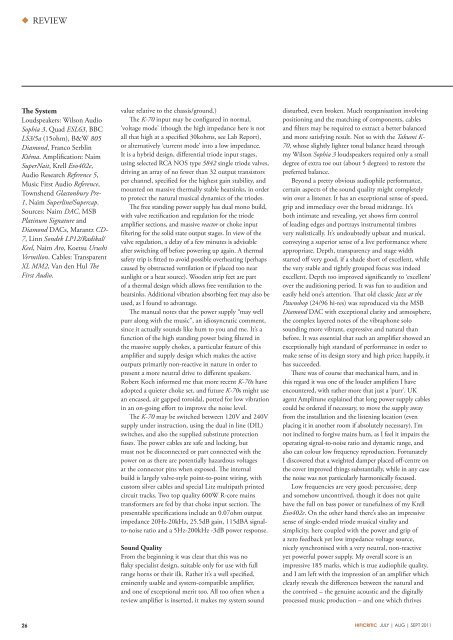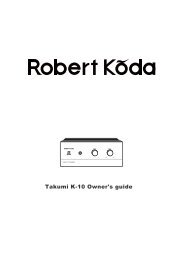hifi critic - Robert koda
hifi critic - Robert koda
hifi critic - Robert koda
Create successful ePaper yourself
Turn your PDF publications into a flip-book with our unique Google optimized e-Paper software.
◆ REVIEW<br />
The System<br />
Loudspeakers: Wilson Audio<br />
Sophia 3, Quad ESL63, BBC<br />
LS3/5a (15ohm), B&W 805<br />
Diamond, Franco Serblin<br />
Ktêma. Amplification: Naim<br />
SuperNait, Krell Evo402e,<br />
Audio Research Reference 5,<br />
Music First Audio Reference,<br />
Townshend Glastonbury Pre-<br />
1, Naim Superline/Supercap.<br />
Sources: Naim DAC, MSB<br />
Platinum Signature and<br />
Diamond DACs, Marantz CD-<br />
7, Linn Sondek LP12/Radikal/<br />
Keel, Naim Aro, Koetsu Urushi<br />
Vermilion. Cables: Transparent<br />
XL MM2, Van den Hul The<br />
First Audio.<br />
26<br />
value relative to the chassis/ground.)<br />
The K-70 input may be configured in normal,<br />
‘voltage mode’ (though the high impedance here is not<br />
all that high at a specified 30kohms, see Lab Report),<br />
or alternatively ‘current mode’ into a low impedance.<br />
It is a hybrid design, differential triode input stages,<br />
using selected RCA NOS type 5842 single triode valves,<br />
driving an array of no fewer than 32 output transistors<br />
per channel, specified for the highest gain stability, and<br />
mounted on massive thermally stable heatsinks, in order<br />
to protect the natural musical dynamics of the triodes.<br />
The free standing power supply has dual mono build,<br />
with valve rectification and regulation for the triode<br />
amplifier sections, and massive reactor or choke input<br />
filtering for the solid state output stages. In view of the<br />
valve regulation, a delay of a few minutes is advisable<br />
after switching off before powering up again. A thermal<br />
safety trip is fitted to avoid possible overheating (perhaps<br />
caused by obstructed ventilation or if placed too near<br />
sunlight or a heat source). Wooden strip feet are part<br />
of a thermal design which allows free ventilation to the<br />
heatsinks. Additional vibration absorbing feet may also be<br />
used, as I found to advantage.<br />
The manual notes that the power supply “may well<br />
purr along with the music”, an idiosyncratic comment,<br />
since it actually sounds like hum to you and me. It’s a<br />
function of the high standing power being filtered in<br />
the massive supply chokes, a particular feature of this<br />
amplifier and supply design which makes the active<br />
outputs primarily non-reactive in nature in order to<br />
present a more neutral drive to different speakers.<br />
<strong>Robert</strong> Koch informed me that more recent K-70s have<br />
adopted a quieter choke set, and future K-70s might use<br />
an encased, air gapped toroidal, potted for low vibration<br />
in an on-going effort to improve the noise level.<br />
The K-70 may be switched between 120V and 240V<br />
supply under instruction, using the dual in line (DIL)<br />
switches, and also the supplied substitute protection<br />
fuses. The power cables are safe and locking, but<br />
must not be disconnected or part connected with the<br />
power on as there are potentially hazardous voltages<br />
at the connector pins when exposed. The internal<br />
build is largely valve-style point-to-point wiring, with<br />
custom silver cables and special Litz multipath printed<br />
circuit tracks. Two top quality 600W R-core mains<br />
transformers are fed by that choke input section. The<br />
presentable specifications include an 0.07ohm output<br />
impedance 20Hz-20kHz, 25.5dB gain, 115dBA signalto-noise<br />
ratio and a 5Hz-200kHz -3dB power response.<br />
Sound Quality<br />
From the beginning it was clear that this was no<br />
flaky specialist design, suitable only for use with full<br />
range horns or their ilk. Rather it’s a well specified,<br />
eminently usable and system-compatible amplifier,<br />
and one of exceptional merit too. All too often when a<br />
review amplifier is inserted, it makes my system sound<br />
disturbed, even broken. Much reorganisation involving<br />
positioning and the matching of components, cables<br />
and filters may be required to extract a better balanced<br />
and more satisfying result. Not so with the Takumi K-<br />
70, whose slightly lighter tonal balance heard through<br />
my Wilson Sophia 3 loudspeakers required only a small<br />
degree of extra toe out (about 5 degrees) to restore the<br />
preferred balance.<br />
Beyond a pretty obvious audiophile performance,<br />
certain aspects of the sound quality might completely<br />
win over a listener. It has an exceptional sense of speed,<br />
grip and immediacy over the broad midrange. It’s<br />
both intimate and revealing, yet shows firm control<br />
of leading edges and portrays instrumental timbres<br />
very realistically. It’s undoubtedly upbeat and musical,<br />
conveying a superior sense of a live performance where<br />
appropriate. Depth, transparency and stage width<br />
started off very good, if a shade short of excellent, while<br />
the very stable and tightly grouped focus was indeed<br />
excellent. Depth too improved significantly to ‘excellent’<br />
over the auditioning period. It was fun to audition and<br />
easily held one’s attention. That old classic Jazz at the<br />
Pawnshop (24/96 hi-res) was reproduced via the MSB<br />
Diamond DAC with exceptional clarity and atmosphere,<br />
the complex layered notes of the vibraphone solo<br />
sounding more vibrant, expressive and natural than<br />
before. It was essential that such an amplifier showed an<br />
exceptionally high standard of performance in order to<br />
make sense of its design story and high price; happily, it<br />
has succeeded.<br />
There was of course that mechanical hum, and in<br />
this regard it was one of the louder amplifiers I have<br />
encountered, with rather more that just a ‘purr’. UK<br />
agent Amplitune explained that long power supply cables<br />
could be ordered if necessary, to move the supply away<br />
from the installation and the listening location (even<br />
placing it in another room if absolutely necessary). I’m<br />
not inclined to forgive mains hum, as I feel it impairs the<br />
operating signal-to-noise ratio and dynamic range, and<br />
also can colour low frequency reproduction. Fortunately<br />
I discovered that a weighted damper placed off-centre on<br />
the cover improved things substantially, while in any case<br />
the noise was not particularly harmonically focused.<br />
Low frequencies are very good: percussive, deep<br />
and somehow uncontrived, though it does not quite<br />
have the full on bass power or tunefulness of my Krell<br />
Evo402e. On the other hand there’s also an impressive<br />
sense of single-ended triode musical vitality and<br />
simplicity, here coupled with the power and grip of<br />
a zero feedback yet low impedance voltage source,<br />
nicely synchronised with a very neutral, non-reactive<br />
yet powerful power supply. My overall score is an<br />
impressive 185 marks, which is true audiophile quality,<br />
and I am left with the impression of an amplifier which<br />
clearly reveals the differences between the natural and<br />
the contrived – the genuine acoustic and the digitally<br />
processed music production – and one which thrives<br />
HIFICRITIC JULY | AUG | SEPT 2011





